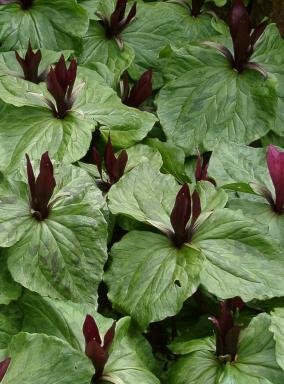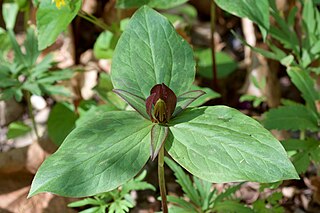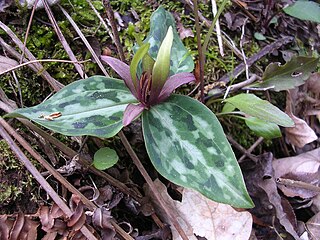
Trillium is a genus of about fifty flowering plant species in the family Melanthiaceae. Trillium species are native to temperate regions of North America and Asia, with the greatest diversity of species found in the southern Appalachian Mountains in the southeastern United States.

Trillium chloropetalum, also known as giant trillium, giant wakerobin, or common trillium, is a species of flowering plant in the family Melanthiaceae. It is endemic to the western U.S. state of California, being especially frequent in and around the San Francisco Bay Area.

Trillium erectum, the red trillium, also known as wake robin, purple trillium, bethroot, or stinking benjamin, is a species of flowering plant in the family Melanthiaceae. The plant takes its common name "wake robin" by analogy with the European robin, which has a red breast heralding spring. Likewise Trillium erectum is a spring ephemeral plant whose life-cycle is synchronized with that of the forests in which it lives. It is native to the eastern United States and eastern Canada from northern Georgia to Quebec and New Brunswick.

Trillium grandiflorum, the white trillium, large-flowered trillium, great white trillium, white wake-robin or French: trille blanc, is a species of flowering plant in the family Melanthiaceae. A monocotyledonous, herbaceous perennial, the plant is native to eastern North America, from northern Quebec to the southern parts of the United States through the Appalachian Mountains into northernmost Georgia and west to Minnesota. There are also several isolated populations in Nova Scotia, Maine, southern Illinois, and Iowa.
Wake-robin, wakerobin, or wake robin are used in the common names of several species of flowering plants, including:
Blue squill is a common name for several plants and may refer to:

Trillium catesbaei, also known as bashful wakerobin or rosy wake-robin, is a spring flowering perennial plant found in the southeastern United States. Like most trilliums, it prefers moist, humus-rich soil in shade. Its northern limit includes the Great Smoky Mountains and other parts of North Carolina and Tennessee. Most of its populations are in the Piedmont from North Carolina to Alabama, under deciduous trees such as American beech, various oak and hickory species, and tulip poplar. Its southernmost natural occurrence is in Escambia County, Alabama.

Trillium discolor, the mottled wakerobin, pale yellow trillium, or small yellow toadshade, is a species of flowering plant in the family Melanthiaceae. It is native to areas of the Savannah River drainage system of Georgia, North Carolina and South Carolina such as Steven's Creek Heritage Preserve and Lake Keowee. It is found along moist stream banks in upland woods, on acidic to basic soils.

Trillium undulatum, commonly called painted trillium, painted lady, or trille ondulé in French, is a species of flowering plant in the bunchflower family Melanthiaceae. It is also known as smiling wake robin or striped wake-robin. The specific epithet undulatum means "wavy", which refers to the wavy edges of the flower petals. The plant is found from Ontario in the north to northern Georgia in the south and from Michigan in the west to Nova Scotia in the east.

Trillium cuneatum, the little sweet betsy, also known as whip-poor-will flower, large toadshade, purple toadshade, and bloody butcher, is a species of flowering plant in the family Melanthiaceae. It is a member of the Trillium cuneatum complex, a subgroup of the sessile-flowered trilliums. It is native to the southeastern United States but is especially common in a region that extends from southern Kentucky through central Tennessee to northern Alabama. In its native habitat, this perennial plant flowers from early March to late April. It is the largest of the eastern sessile-flowered trilliums.

Trillium sessile is a species of flowering plant in the bunchflower family Melanthiaceae. The specific epithet sessile means "attached without a distinct stalk", an apparent reference to its stalkless flower. It is commonly known as toadshade or toad trillium. It is also called sessile trillium or sessile-flowered wake-robin, however it is not the only member of the genus with a sessile flower.

Trillium lancifolium, the lanceleaf wakerobin, lance-leaved trillium, or narrow-leaved trillium, is a species of plants native to the southeastern United States. It is known to occur in Alabama, Florida, Georgia, Mississippi, South Carolina, and Tennessee. The species is imperiled in Alabama and Florida, and critically imperiled in South Carolina and Tennessee.

Trillium pusillum is a species of flowering plant in the family Melanthiaceae known by the common names dwarf trillium, least trillium and dwarf wakerobin. It is native to the southeastern and south-central United States from Oklahoma to Maryland.

Trillium albidum is a species of flowering plant in the bunchflower family Melanthiaceae. It is the only trillium characterized by a stalkless white flower. The species is endemic to the western United States, ranging from central California through Oregon to southwestern Washington. In the San Francisco Bay Area, it is often confused with a white-flowered form of Trillium chloropetalum. In northern Oregon and southwestern Washington, it has a smaller, less conspicuous flower.

Trillium recurvatum, the prairie trillium, toadshade, or bloody butcher, is a species of perennial herbaceous flowering plant in the family Melanthiaceae. It is native to parts of central and eastern United States, where it is found from Iowa south to Texas and east to North Carolina and Pennsylvania. It grows in mesic forests and savannas, often in calcareous soils. It is also known as bloody noses, red trillium, prairie wake-robin, purple trillium, and reflexed trillium, in reference to its reflexed sepals.

Trillium reliquum, the relict trillium, Confederate wakerobin, or Confederate trillium, is a monocotyledon species of the genus Trillium, a perennial, flowering, herbaceous plant of the family Liliaceae. It is found only in the southeastern region of the United States: southeast Alabama and central and west Georgia, with a disjunct population in east Georgia and southwest South Carolina. As a relict species, there are a few remaining groups but it was once more abundant when conditions were different. Significant habitat loss has occurred through clearing of forests for agricultural and pine farm uses.
Nodding wakerobin is a common name for several plants and may refer to:
Nodding trillium is a common name for Trillium cernuum, a flowering plant native to North America.
White trillium is a common name for Trillium grandiflorum, a flowering plant native to North America.













